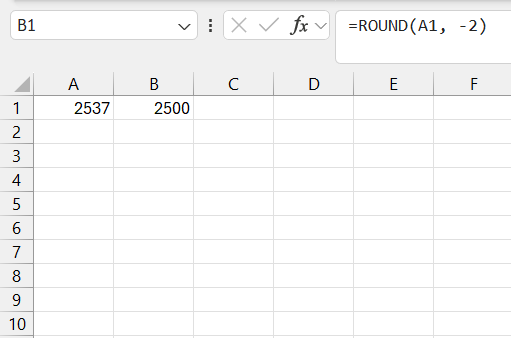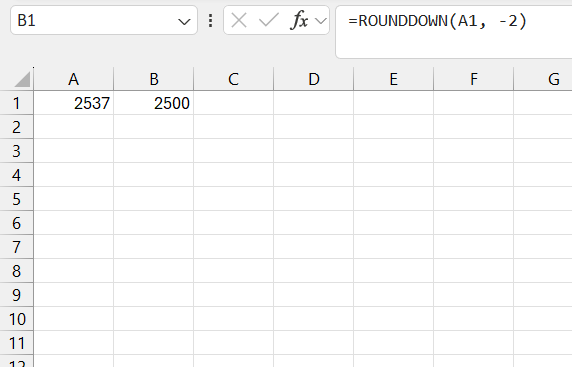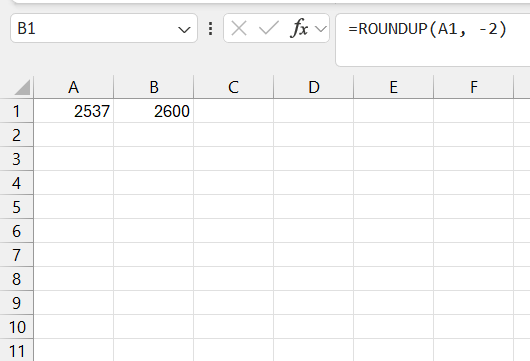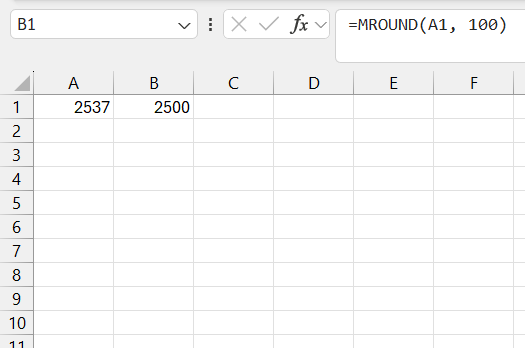When working with numbers in Excel, you might encounter situations where you need to simplify large numbers by rounding them to the nearest hundred. Excel provides multiple functions to round numbers to a specified precision, allowing you to clean up your data for easier analysis or presentation. Here’s a detailed guide on how to round to the nearest hundred in Excel using various functions.
Key Takeaways:
- Excel provides various functions like ROUND, ROUNDUP, ROUNDDOWN, and MROUND for rounding numbers to the nearest hundred.
- Use the ROUND function with -2 digits to round numbers to the nearest hundred in Excel.
- ROUNDUP rounds up, and ROUNDDOWN rounds down to the nearest hundred, regardless of the actual number’s proximity.
- The MROUND function helps round to the nearest specified multiple, such as 100.
Table of Contents
Introduction to Rounding in Excel
Understanding the Basics of Rounding Numbers
When we talk about rounding numbers, I’m really referring to the process of simplifying them. Just like one might look at a basket overflowing with fruit and estimate instead of counting each piece, rounding a number like 168 to a cleaner, approximate figure such as 200 is a practical simplification.
This technique is invaluable within Excel, where it enhances the readability and comprehension of large sets of data by scaling them down to their most essential form without losing significant meaning.
Let me illustrate: Imagine you’re skimming through a dense report full of precise values—rounding helps to capture the essence of those numbers in a less daunting way, making it substantially easier for us to analyze and communicate our findings.
The Importance of Precision in Data Analysis
When it comes to data analysis, precision isn’t a luxury; it’s a necessity. We must tread very carefully here because while rounding makes numbers easier to handle, premature or unwarranted rounding can dilute our data’s integrity, leading to less informed decisions.
It’s a bit of a balancing act – raw, exact figures provide the clearest insights and most profound findings during the initial stage of analysis, supporting us in identifying patterns and outliers.
But after we’ve crunched the numbers and derived the insights, simplifying them through rounding can make our conclusions more digestible to a broader audience. Think about budgets, sales reports, or any financial statement: clarity often matters as much as accuracy in these documents, and rounding can enhance that clarity without significantly compromising detail.
How to Round to the Nearest Hundred in Excel
Using the ROUND Function
The ROUND function is commonly used to round numbers to a specific number of digits. To round to the nearest hundred, you must round to -2 digits. The formula works like this:
Syntax: =ROUND(number, num_digits)
number: The number you want to round.num_digits: The number of digits to round to. For the nearest hundred, use-2.
Example: If you have the number 2537 in cell A1 and want to round it to the nearest hundred, use this formula:
=ROUND(A1, -2)
This would return 2500, as 2537 is closer to 2500 than 2600.
The ROUNDDOWN Function
If you want to round down to the nearest hundred (always rounding towards zero), you can use the ROUNDDOWN function.
Syntax: =ROUNDDOWN(number, num_digits)
Example: Using the same number 2537 in cell A1:
=ROUNDDOWN(A1, -2)
This would return 2500, as it rounds down regardless of whether the number is closer to the next hundred.
The ROUNDUP Function
To always round up to the nearest hundred, you can use the ROUNDUP function, which forces the number to be rounded up, even if it’s closer to the lower hundred.
Syntax: =ROUNDUP(number, num_digits)
Example: For 2537 in cell A1:
=ROUNDUP(A1, -2)
This would return 2600, rounding up to the next hundred.
Using the MROUND Function
The MROUND function allows you to round numbers to the nearest multiple of any value, such as 100 in this case.
Syntax: =MROUND(number, multiple)
number: The number you want to round.multiple: The multiple to which you want to round. For nearest hundred, the multiple is100.
Example: For the number 2537 in cell A1:
=MROUND(A1, 100)
This would return 2500, as it rounds 2537 to the nearest multiple of 100.
Tips and Tricks for Rounding Large Datasets
Utilizing Fill Handle for Quick Rounding Across Rows
For those moments when I need to round a vast array of numbers across multiple rows, the Fill Handle feature in Excel is a true timesaver. This little square at the corner of an Excel cell is like a magic wand; I drag it across the other cells, and presto—my rounding formula is copied quickly and efficiently throughout.
Using the Fill Handle, I can avoid the tedious task of entering or copying formulas into numerous cells. I sometimes combine it with the ‘Double-Click’ trick—with just a double click on the Fill Handle, Excel automatically fills the formula down the entire column, as long as there’s adjacent data. This trick is particularly helpful when working with extensive datasets, allowing me to round hundreds, if not thousands of numbers, in a snap.
Incorporating Rounding Into Complex Formulas
Incorporating rounding into complex Excel formulas doesn’t have to be an intimidating task. I find that it’s all about understanding the flow of the calculation and pinpointing where the rounding should occur to produce the desired outcome. It’s like a chef adding a pinch of salt at the right stage to bring out the best in a dish.
For example, when working with compound formulas where several operations take place, I include rounding in a way that doesn’t disrupt the formula’s logic flow. Usually, I surround the portion of the formula that I want to round with the ROUND function. This can help to avoid cumulative rounding errors over a series of calculations, ensuring each step’s accuracy is maintained and leads to an accurate final result.
Real-World Examples of Rounding in Action
Case Study: Rounding Sales Figures for Quarterly Reports
One particularly telling example of rounding’s real-world value was when I worked with a retail company to streamline their quarterly sales reports. Initially, their reports were cumbersome, filled with exact sales figures down to the cent for thousands of products. It was hard for executives to discern the larger trends at a glance.
We implemented a system where sales figures were rounded to the nearest hundred. This transformed the reports into succinct summaries, offering a swift understanding of the overall sales performance. By focusing on significant digits, the company’s decision-makers could quickly gauge their progress and make more informed strategic decisions.
Example: Using Rounding to Estimate Budget Allocations
Estimating budget allocations is another area where rounding can play a crucial role, as I witnessed with a non-profit I assisted. They grappled with intricate budgets detailed to the last penny, making it tough for department heads to make prompt funding decisions.
By employing rounding to the nearest hundred or thousand, depending on the size of the budget, we made estimations more accessible and the process much more efficient. This did not just simplify internal communications; it actually expedited the budget approval process, as board members could more easily understand and discuss the numbers.
FAQ: Mastering Excel’s Rounding Capabilities
What is the formula for rounding in Excel?
The formula for rounding numbers in Excel is the ROUND function, defined as =ROUND(number, num_digits). You replace ‘number’ with the value you want to round, and ‘num_digits’ with the number of digits to which you want to round the number. If you’re rounding to the nearest whole number, ‘num_digits’ would be 0.
How to round to the nearest hundred in Excel?
To round to the nearest hundred in Excel, use the ROUND function with a formula structured as =ROUND(A1, -2), where A1 is the cell with the number you want to round. Inserting ‘-2’ indicates you wish to round the figure to the hundred’s place. It’s a simple and effective method for achieving clarity in your data.
What is the difference between ROUND and MROUND in Excel?
The difference between ROUND and MROUND in Excel is their rounding approach. ROUND rounds a number to a specified number of digits, controlled by you. For instance, to round to tens, hundreds, or to a decimal place. MROUND, on the other hand, rounds a number to the nearest specified multiple that you provide, say the nearest 0.05 or 5. The choice depends on the precision your task requires.
How can I round a column of numbers to the nearest hundred automatically?
To round a column of numbers to the nearest hundred automatically in Excel, input the ROUND function with the formula =ROUND(A1, -2) in the first cell of the adjacent column, replacing A1 with the cell reference of the first number. Then, use the Fill Handle to drag the formula down the column. Excel automatically adjusts the formula for each row. This method swiftly applies rounding to all cells in the column.
Can rounding in Excel affect the accuracy of my results?
Yes, rounding in Excel can affect the accuracy of your results, especially if done prematurely in multi-step calculations. Small rounding discrepancies can accumulate, leading to a significant impact on sums, averages, and other aggregates. It’s best to round as a final step or use rounding functions that maintain data integrity throughout the calculation process to mitigate errors.
John Michaloudis is a former accountant and finance analyst at General Electric, a Microsoft MVP since 2020, an Amazon #1 bestselling author of 4 Microsoft Excel books and teacher of Microsoft Excel & Office over at his flagship MyExcelOnline Academy Online Course.











